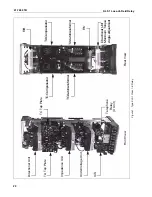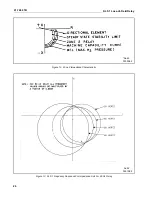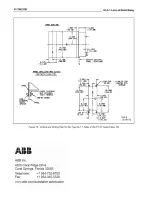
41-748.31B
15
KLF-1 Loss-of-Field Relay
2.
Disconnect the L-leads of sections M
A
and
M
C
.
3.
Pass 10 amperes ac current in terminal 9
and out of terminal 8.
4.
Measure the compensator voltage with an
accurate high resistance voltmeter (5000
ohms/volt).
5.
Compensator A voltage should be checked
between lead L
A
and terminal 5.
a.
For T
A
= 15.8 the voltage measured
should be 158 volts
±
3%.
6.
Compensator C voltage should be checked
between lead L
C
and terminal 5.
a.
For T
C
= 5.1, the voltage should be 51
volts (
±
3%).
7.
For all other taps the compensator voltage is
IT (
±
3%).
where I
= relay
current
T = tap setting.
10.0 ADJUSTMENTS AND
MAINTENANCE –
FOR RELAYS RATED
AT 120 VAC
The proper adjustments to insure correct operation of
this relay have been made at the factory. Upon
receipt of the relay, no customer adjustments,
other than those covered under “SETTINGS”, should
be required.
10.1 ACCEPTANCE CHECK
The following check is recommended to insure that
the relay is in proper working order:
Note:The relay should be energized for at least
one hour.
A. Impedance Unit (Z)
1. Connect the relay as shown in Figure 9 (Dia-
gram of Test Connections for KLF-1 Relay
on page 24) with the switch in position 2 and
the trip circuit de-energized.
2.
Make the following tap settings:
T
A
= 11.5
T
C
= 2.55
S
A
= 2
S
C
= 1
M
A
= -.03 (R/L)
M
C
= -.09 (R/L)
The reversing links should be set for +T
C
direction (vertical).
This setting corresponds to Z
A
= 23.7 and Z
C
= 2.80 ohms.
Adjust the phase shifter for 90° current lag-
ging the voltage.
3.
With the terminal voltage at 90 volts,
increase current until contacts just close.
This current should be within
±
3% of 3.80
amp (3.686 - 3.914 amp).
4.
Adjust phase shifter for 90° current leading
the voltage.
5.
With the terminal voltage at 90 volts increase
current until contacts just close. This current
should be within
±
3% of 32.14 amps, (31.18 -
33.11 amps).
Contact Gap – The gap between the station-
ary contact and moving contact with the
relay in de-energized position should be
approximately .040”.
B. Directional Unit Circuit (D)
1. Connect the relay as shown in Figure 9 (Dia-
gram of Test Connections for KLF-1 Relay
on page 24), with the switch in position 1 and
the trip circuit de-energized.
2.
With a terminal voltage of 1 volt and 5
amperes applied, turn the phase shifter to
43° (current leads voltage). The contacts
should be closed. This is the maximum
torque position.
3.
Raise the voltage to 120 volts and vary the
phase shifter to obtain the two angles where
the moving contact just makes with the
left-hand contact. These two angles (where
torque reverses) should be where the current
leads the voltage by 313° and 133°,
(±
4°).
4.
Contact Gap – The gap between the station-
ary contact and moving contact with the relay
in de-energized position should be approxi-
mately .020”.
C. Undervoltage Circuit
1. Connect the relay as shown in Figure 9 (Dia-
gram of Test Connections for KLF-1 Relay
on page 24), with switch in position 2 and the
trip circuit de-energized.




























